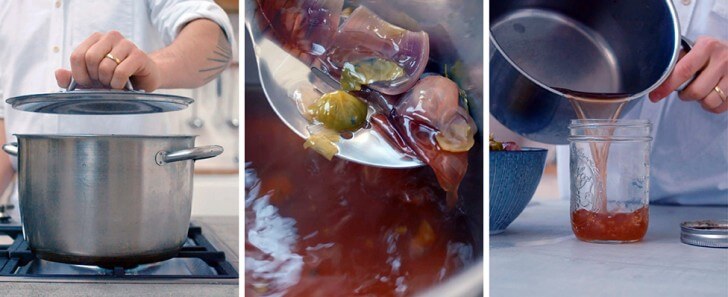BBC Earth newsletter
BBC Earth delivered direct to your inbox
Sign up to receive news, updates and exclusives from BBC Earth and related content from BBC Studios by email.
Food
290,000 tonnes of perfectly drinkable milk is wasted every year in the UK.

Here are some recipes that can help you reduce food waste in your kitchen.
FOR THE PESTO:
Rough bunch of herbs, 1 handful, stems only
35g nut of choice (walnuts or pine nut)
1 clove of garlic
½ lemon, juice of
30g cheese of choice, (eg parmesan, cheddar, or plant-based equivalent such as nutritional yeast
1tsp salt
1tsp black pepper
3tbsp olive oil
FOR THE SOCCA
1 cup of chickpea flour (100g)
1tsp baking powder
1tsp salt
1 garlic clove, finely chopped
1tsp nutritional yeast
240ml of water
Handful of chopped herbs such as coriander (optional)
½ red onion, thinly sliced
To a blender or food processor, add the herb stems, roughly 35g of a nut of your choice, today I’m using pine nuts, 1 clove of garlic, the juice of half a lemon, roughly 30g of cheese - i’m using a great alternative - nutritional yeast -. 1 tsp salt, black pepper and 3 tbsp of olive oil.
Blend to your desired consistency.

I’m gonna put this pesto on top of savoury French pancake, called a Socca, made from chickpea flour.
To a mixing bowl, add 1 cup of chickpea flour also known as gram flour, 1tsp baking powder, a teaspoon of salt, a finely chopped clove of garlic, 1 tsp of nutritional yeast, about 240ml of water, and mix it all together. Now leave it to sit for 15 to 20 minutes.
Then add 1tbsp of olive oil, a handful of chopped herbs - today I’m using coriander and stir this all together.
Heat a frying pan over a medium heat and ladle in spoonfuls of batter to form a thin layer. Add some sliced red onion on top. We’re not gonna flip this, but once the top is cooked, you can serve your socca. I’m topping it with rocket, a plant-based cheese and the homemade herb stem pesto.

The question I get asked the most is ‘What can I do with my vegetable tops and tails, odds and ends?’. This is the recipe that solves this problem. Not only are you not wasting food you’re also eliminating single use plastic and giving your food a second life.
Here’s a tip – every time you cook from now on, place a bowl beside your cutting board. Any trimmings that don’t go towards cooking go into the bowl. Save these scraps in a sealed reusable bag in your freezer. Once you have about 2–4 cups of food scraps, you’re ready to make your stock and ditch the premade supermarket plastic packaged stock.
Makes about 500ml.

INGREDIENTS
ends of onions and skins
Skin of garlic cloves
carrot peelings and trimming
potato skins
those unwanted Brussels sprout leaves
Any part of broccoli that has seen better days
any part of the celery
that green stem of a pepper
beetroot leaves
cauliflower core and leaves
soft mushrooms
banged up tomatoes
wilted leafy greens that are done for
herbs that were never used
Put your vegetable scraps into a big saucepan, and pour in enough water to cover your scraps (around 700ml). You may add a bay leaf, salt and peppercorns to help out with the seasoning.
Bring to the boil and leave to simmer for 30–40 minutes. You’ll know it’s ready when the vegetables have wilted and are soft and the liquid has turned a slightly darker colour and gives off an earthy aroma.
Strain the food scraps and collect the liquid. Fill containers with your homemade vegetable stock and store in jars in your fridge for up to 1 week or in freezable containers in your freezer for 1 month.
Us the stock for making soups, stews, curries, and even to cook your pasta in.
Enjoy!
Featured image © Johner Images | Getty